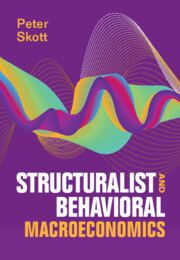Book contents
- Frontmatter
- Contents
- Figures
- Preface and Acknowledgments
- 1 Introduction: The State of Macroeconomics
- 2 The Lucas Critique and Representative Agents
- 3 Household Consumption and Saving
- 4 Saving in a Corporate Economy
- 5 Phillips Curves and the Natural Rate of Unemployment
- 6 Fairness, Money Illusion, and Path Dependency
- 7 Earnings Inequality, Power Bias, and Mismatch
- 8 Macroeconomic Adjustment and Keynes’s Instability Argument
- 9 Growth and Cycles
- 10 Endogenous Growth Cycles with or without Price Flexibility
- 11 Secular Stagnation and Functional Finance
- 12 Concluding Comments: Evidence-Based Macroeconomics and Economic Theory
- References
- Author Index
- Subject Index
11 - Secular Stagnation and Functional Finance
Published online by Cambridge University Press: 10 November 2023
- Frontmatter
- Contents
- Figures
- Preface and Acknowledgments
- 1 Introduction: The State of Macroeconomics
- 2 The Lucas Critique and Representative Agents
- 3 Household Consumption and Saving
- 4 Saving in a Corporate Economy
- 5 Phillips Curves and the Natural Rate of Unemployment
- 6 Fairness, Money Illusion, and Path Dependency
- 7 Earnings Inequality, Power Bias, and Mismatch
- 8 Macroeconomic Adjustment and Keynes’s Instability Argument
- 9 Growth and Cycles
- 10 Endogenous Growth Cycles with or without Price Flexibility
- 11 Secular Stagnation and Functional Finance
- 12 Concluding Comments: Evidence-Based Macroeconomics and Economic Theory
- References
- Author Index
- Subject Index
Summary
Aggregate demand problems can jeopardize the existence of a steady growth path in mature capitalist economies: fiscal policy may be needed to maintain full employment and avoid secular stagnation. This functional finance approach to economic policy endogenizes the movements in public debt. The debt ratio will converge towards a long-run value that depends (i) inversely on the rate of growth, (ii) inversely on government consumption, and (iii) directly on the degree of inequality. The analysis implies that policies and policy debates on the dangers of public debt have been misguided and that the incipient theoretical redirection following the rediscovery of secular stagnation by Summers and others does not go far enough. Unlike in mature economies, functional finance cannot target full employment in developing economies with high rates of underemployment. Instead, high investment rates are desirable, and functional finance should aim to stabilize the level and composition of demand at values that are consistent with a target growth rate of the modern sector; excessive aggregate demand stimulus can squeeze the modern sector and lead to premature deindustrialization.
Keywords
- Type
- Chapter
- Information
- Structuralist and Behavioral Macroeconomics , pp. 299 - 335Publisher: Cambridge University PressPrint publication year: 2023



